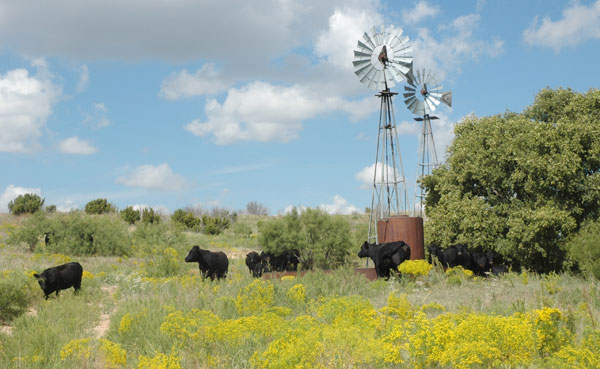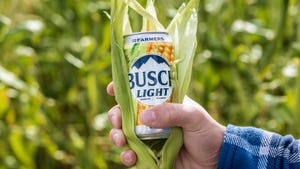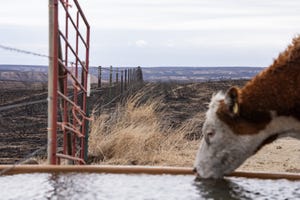Effective Heifer Development Means Thinking Early & Long Term
How beef heifers are developed and how quickly they breed go a long way in determining their lifelong productivity in the cowherd.
September 4, 2014

“When heifers get pregnant is extremely important to profitability,” says Rick Funston, a University of Nebraska-Lincoln (UNL) beef reproduction physiologist at the West Central Research and Extension Center in North Platte. “A cow that calves in the first cycle during her lifetime will produce the equivalent of two more calves on the same resources. That’s powerful.”
There are two parts to this equation: when heifers calved the first time and when in the calving season the heifer was born.
First, research from the U.S. Meat Animal Research Center affirms the fact that heifers calving early in their first calving season have increased longevity and wean more pounds of calf, compared with heifers calving later with their first calf.
Next, Funston compiled research involving 1,019 heifers (Figure 1). Those born in the first 21 days of the calving season were heavier at weaning and breeding. Significantly more heifers cycled in the first 21 days with a higher conception rate. Significantly more heifers (81%) born in the first 21 days went on to calve themselves in the first 21days, compared to heifers born in the second cycle (69%) and third cycle (65%).
Funston believes producers can get a long way toward achieving this with the heifers they select, and by paying attention to how much weight heifers gain and when.
Eliminate the usual suspects
At this summer’s annual meeting of the Beef Improvement Federation (BIF), Funston offered selection criteria espoused by Jim Gosey, UNL Extension beef specialist emeritus.
Assuming that open cows are culled, Gosey suggested getting rid of daughters from cows that:
Calve late (42 days or more in the breeding season)
Need help calving
Fail to wean a calf
Wean a lighter calf
Have big teats and need help with calves nursing
Have an attitude problem
Gosey also suggested that heifers from the older cows in the herd deserved extra consideration as keepers. Though that runs counter to the notion that the youngest cows should be the most genetically advanced, Funston explains the older cows have proven their ability to survive longest in your ranch environment.
“Keep the heifers that are born early. They’re heavier at weaning, they’re better cycling, better breeding, and have higher pregnancy rates and more calves born in the first 21 days,” Funston emphasizes.
Use a working cow environment
Next, Funston encourages producers to develop replacement heifers with the kind of feed resources they’ll have for most of their lives. Don’t rely on artificial nutritional environments. “I think we do heifers a huge disservice by locking them up and making them gain 3-4 lbs./day,” Funston says. “Our mentality has been to lock heifers up, feed them silage, distillers grain and alfalfa hay, get them all pregnant, and then turn them out and say, ‘Oh, by the way, you’ll never see that kind of nutrition again.’”
Alluding to research from New Mexico, Montana and Nebraska, Funston explains that restricting gain during post-weaning development — by limiting dry matter intake or developing heifers on dormant winter forage — resulted in increased economic advantages compared with developing heifers at greater rates of average daily gain (ADG) to achieve a greater target breeding weight.
“Collectively, these studies provide evidence that developing heifers to lighter weights at the start of breeding reduces maintenance requirements, providing them with greater opportunity to be in positive nutrient balance in conditions when forage quality is marginally sufficient around the time of breeding,” Funston explains.
“Differences in size and corresponding maintenance requirements may persist over time to result in greater retention in subsequent years. Pregnancy rates through the fourth calf remained similar between high-gain and low-gain heifers developed in Nebraska, where nutrition following the development period was considered adequate.”
The target weight debate
A growing body of research and experience suggests heifers developed to lighter breeding weights — 50%-55% of mature body weight vs. the traditional target of 60%-65% — can be as productive at less cost. Keep in mind these studies are based on Bos taurus cattle.

Rick Funston, University of Nebraska-Lincoln
“Research in the last decade has compared traditional, more intensive systems with systems using less feed and relying on compensatory gain,” Funston explains. “These studies provide evidence that developing heifers to a lighter target body weight [BW] at breeding [50%-57% of mature BW], compared with 60%-65% BW, reduced development costs while not impairing reproductive performance.”
In UNL research, for instance, the pregnancy percentage was statistically similar for heifers developed on mostly dormant forage and corn residue (0.94 lb. ADG and 93% pregnant) and for those developed more intensely in a dry-lot environment (1.30 lbs. ADG and 91% pregnant).
One reason the 65% target can be excessive is the simple fact that genetics today are different from those used to establish the recommendation. Consider the difference between research cattle of the 1960s and the 1980s.
According to Funston, the relationship between BW, puberty and heifer pregnancy rate appears to have changed over time. Among other things, he believes these changes stem from:
The shift to calving heifers at 2 years of age rather than 3 years
Selection pressure for decreased age at puberty, including selection pressure for bulls with larger yearling scrotal measurements
A possible change in fertility of pubertal estrus compared with subsequent estrus cycles.
Funston notes another contributing factor is the correlation between production traits that producers select for and reproductive performance. As breeds have selected for increased weaning and yearling gain, for instance, logic suggests heifer breeding weights are heavier.
None of this is to suggest that breeders should blindly and simply develop heifers to lighter weights.
“Collectively, rebreeding results from New Mexico and Nebraska would indicate that lower-input heifer development, where all heifers are managed together after the post-weaning period, did not impair rebreeding. However, continued subsequent restriction in the form of marginal winter supplementation resulted in lower retention rates in 2-year-old and 3-year-old cows,” Funston says.
Likewise, John Hall, a University of Idaho professor of animal science, says, “Consideration must be given to heifer biological type, breeding [purebred vs. crossbred], development costs and marketing options before selecting or recommending a target weight [percentage of mature weight] goal.”
In his paper, “Management Considerations in Beef Heifer Development and Puberty from Veterinary Clinics of North America: Food Animal Practice,” Hall cautions, “The studies supporting the 55% target weight were conducted with crossbred/composite heifers, which tended to reach puberty earlier. A follow-up study indicated that developing heifers to 50% mature BW compared to 55% BW resulted in similar overall pregnancy rates, but decreased calf weaning weight from 2-year-old cows and delayed calving in 3-year-old cows … Although overall pregnancy rates were not compromised by the 55% target weight, several studies indicated decreased conception early in the breeding season or to artificial insemination.”
In order for low-input heifer development to be effective, Funston explains, an appropriate level of nutrition immediately prior to breeding and continuing through subsequent calving is required for low-input developed heifers to experience compensatory gain, and attain sufficient size and body condition. This allows them to successfully calve and rebreed.
“Providing adequate nutrition during this phase has shown rebreeding rates as 2-year-olds to be equal to or greater than heifers that received higher energy during development, and were a larger percentage of mature body weight at breeding. Body condition at calving should be 5 or greater,” he says.
Hall adds that low-input heifer development is more conducive to larger herds, which can keep back more potential replacements and place more pressure on early conception. “Another way of thinking about it is that there’s little room for error when developing heifers to a target weight of 55%. Developing them to heavier target weights is more forgiving,” he explains.
Funston says producers using low-input replacement heifer development should consider retaining all potential replacement females and expose them for a short 45 days or less) breeding season.
“Producers who can afford to breed extra heifers should do so, providing themselves the opportunity to pick replacement heifers that conceived earliest by estimating fetal age at pregnancy diagnosis,” Funston says.
Even when heavier heifer breeding weights are needed, Funston stresses there’s ample time between weaning and breeding.

Can You Tell Profit When You See It?
Enter our 2014 BEEF Efficiency & Profit Contest here & you could win $1,000 cash (individual) or $5,000 in Merial product (feedlot group). Enter here!
“Essentially, a heifer never needs to gain more than 1.5 lbs./day, even to get to a target weight that we know far exceeds the weight she needs to be in order to breed,” Funston says.
“By breeding more replacement heifers than required, cow-calf producers can choose those that conceived earliest at pregnancy diagnosis. By doing this, they should be able to increase the proportion of heifers that wean enough calves to pay for their development costs earlier. In addition, the increased weaning weights during the first six seasons will increase the profit margin for the operation,” Funston explains.
Think beyond breeding season
For that matter, Funston adds, “We’re learning that heifer development doesn’t stop at breeding. We tend to manage heifers up to breeding and say, ‘OK, they’re at this breeding weight, and here are our expectations for pregnancy.’ ”
The problem with that thinking, Funston says, is that bred heifers and cows lose 30%-40% of embryos before 30 days, due in part to the fact they’re not gaining post-breeding.
“I always want to design a program for any breeding female so that she will be gaining more during the next step, as she is establishing pregnancy, than she did in the last step,” Funston says.
This is another developmental stage where low-input development ahead of breeding can shine. “It’s amazing what heifers will do when they go to a higher plane of nutrition such as good grass. The compensatory gain that the yearling industry has known about for years, works with heifers, too,” Funston says.
“Until you geneticists give me better tools to work with, maybe the best thing we can do is expose all of our heifers and keep only those that get pregnant early — the first 21 days of the breeding season,” Funston told the crowd at BIF. “That’s probably the single most important indicator of profitability in beef cow operations.”
You might also enjoy:
Beef Demand Roars, Record Cattle Prices Projected Into 2015
Enjoy This --> Picture Perfect Summer Grazing Scenes From Readers
Grass-Fed Vs Grain-Fed Ground Beef | Are There Any Difference In Healthfulness?
How To Prevent & Treat Pinkeye In Cattle
100+ Photos Of Our Favorite Ranch Dogs
How Drones May Change Food Production From Pasture To Plate
About the Author(s)
You May Also Like



.png?width=300&auto=webp&quality=80&disable=upscale)

